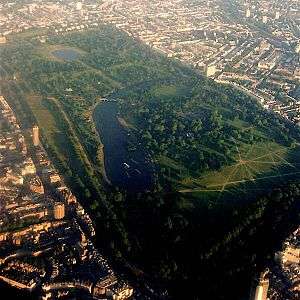Hainault Forest
| Site of Special Scientific Interest | |
 The large lake in Hainault Forest Country Park | |
| Area of Search |
Greater London Essex |
|---|---|
| Grid reference | TQ477938 |
| Interest | Biological |
| Area | 136.0 hectares |
| Notification | 1986 |
| Location map | Magic Map |


Hainault Forest Country Park is located in Greater London, with portions in: Hainault in the London Borough of Redbridge; the London Borough of Havering; and in the Lambourne parish of the Epping Forest District in Essex.[1]
Geography
With an area of 336 acres (136 hectares), Hainault Forest Country Park is a Site of Special Scientific Interest.[2]
The Redbridge section of the park is being developed by the Redbridge Council as a country park. The Essex section is managed by the Woodland Trust, who are contracted to do so by its owners, Essex County Council.[1][3]
History
Hainault Forest is one of the remaining sections of the former Forest of Essex in England. Epping Forest and Hatfield Forest are other remaining examples. The forest belonged to the abbey of Barking until the Dissolution of the Monasteries;[4] it extended northwards to Theydon Bois, east to Havering-atte-Bower, on the south to Aldborough Hatch,[5] and westwards to Leytonstone.[6] In a survey made for Henry VIII in 1544 its extent was some 3,000 acres (12 km2).[7]
The forest land was condemned as waste by an Act of Parliament, 1851, disafforested, the deer removed, and 92% of the old growth forest cut down. The land became marginal agricultural land and subsequently a significant proportion has been built on. The destruction was deplored by Sir Walter Besant in his works on London: the forest is also the setting for his novel All in a Garden Fair.
Oliver Rackham described how the outrage at the destruction of Hainault led to the modern conservation movement with the creation of conservation groups which successfully opposed such a fate happening to Epping Forest.
Preservation
After public pressure to retain some remnant of Hainault Forest, headed by Edward North Buxton,[8] a total of 804 acres (3.3 km2) of land was bought for public use on 21 July 1906. It included 253 acres (1.0 km²) of woodland and rough pasture.
Hainault Forest Country Park protected areas include: open space parklands — with numerous public footpaths and a large lake; Hainault Forest Golf Club; and Fox Burrow Farm — which is used in part for preserving rare breeds of animals.
See also
- List of Sites of Special Scientific Interest in Greater London
- List of Sites of Special Scientific Interest in Essex
References
- 1 2 "HAINAULT FOREST". hainaultforest.co.uk.
- ↑ "Natural England citation, Hainault Forest" (PDF). Natural England. Retrieved 13 March 2010.
- ↑ "Hainault Forest". Woodland Trust. Retrieved 15 January 2016.
- ↑ Barking Side preserves the connection.
- ↑ Hatch, a gateway to the forest preserve.
- ↑ N. D'Anvers, The Historical Outskirts of London 1907, p. 72
- ↑ "Hainault Forest Website". hainaultforest.co.uk.
- ↑ Mr Buxton is credited in D'Anvers 1907 , p. 72.
Coordinates: 51°37′18″N 0°7′45″E / 51.62167°N 0.12917°E
| Wikimedia Commons has media related to Hainault Forest Country Park. |
External links
- Unofficial Hainault Forest Country Park website
- London Gardens Online: Hainault Forest Country Park website
- Natural England: Citation — Hainault Forest
- "Map of Hainault Forest". Natural England.
